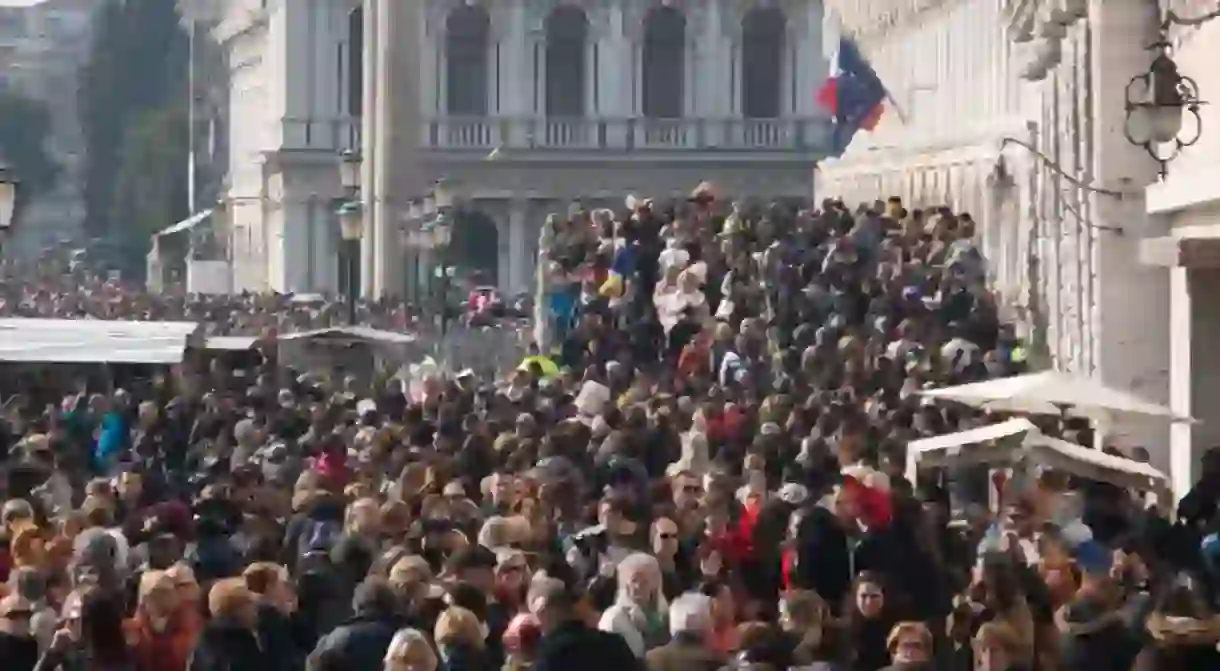Tourismophobia Is a Thing and Here’s Everything You Need to Know About It

This summer saw an unprecedented wave of so-called ‘anti-tourist’ protests sweep through Europe. As residents of tourist hot-spots get ever more vocal and travellers start to wonder whether they’re welcome abroad anymore, we look closer at what has since been dubbed the ‘rise of tourismophobia’. Is the situation really as bad as it seems?
A summer of anger
Anyone who has visited Barcelona in recent years will have noticed the ‘Tourist go home’ graffiti, or ‘Tourism kills neighbourhoods’ banner hanging from a balcony. Some local residents, it seems, are not all that happy with their city’s popularity.
However, the summer of 2017 saw an unprecedented wave of anti-tourism protests in some of Europe’s most popular destinations. Thousands of people took part in protests in cities such as Venice, Rome, Dubrovnik, and Amsterdam, decrying soaring rent prices, the environmental impact of the tourist industry on their cities and a general feeling of being ‘overrun’ by tourists.

In Barcelona, members of a local political youth wing, Arran, slashed the tyres of tourist bikes and also a tourist bus. Justifying the group’s actions to the BBC, a spokesperson stated: “Today’s model of tourism expels people from their neighbourhoods and harms the environment.”
By August the headlines declared that ‘tourists are no longer welcome’, and ‘residents hate tourists’ in these angry tourist hotspots. Meanwhile local governments took measures to appease residents and restore order.
In Barcelona, moratorium on the creation of new hotel rooms and tourist flats in key areas of the city has already been in place for a number of years. In Milan a ban on selfie-sticks was introduced around certain landmarks, while Rome launched a crack-down on littering and paddling in public fountains.

When tourism becomes a problem
If tourism has traditionally been seen as a positive for cities – driving the local economy, creating new jobs and business opportunities, improving transport infrastructure – it seems that some local residents are frustrated with the social and environmental downfall of a tourism they consider to be out of control.
In Venice, a city of some 55,000 residents, there are an estimated 20 million tourists who visit the city each year. In Dubrovnik, some 5,000 people disembarked from cruise ships and descended on the historic city centre in a single day in June.

In Barcelona, over 52 percent of the buildings in the Gothic Quarter contain tourist flats and there has been an increase of 25 percent in the number of tourists who visit the city in just four years between 2012 and 2016.
Many of these tourists stay in accommodation rented through websites such as Airbnb or HomeAway, which the local authorities have accused of listing some 7,000 illegal flats – flats which do not have the proper tourist licence and are as such unregulated and unaccountable. At the same time there has been an average 16 percent annual raise in the cost of long-term flat rents in Barcelona.
Certain residents find themselves unable to keep up the cost of living in their city, perceiving that in their case the social cost of tourism outweighs the presumed economic advantages.

Elsewhere, the problem is framed in terms of the environmental cost as residents worry about the impact of the arrival of so many cruise ships in their ports on the quality of the water and their beaches. In places such as Mallorca, drinkable water is also scarce and tourism puts extra pressure on its already scant resources.
The right kind of tourism
Despite their frustrations, it seems that in most cases it is not an outright ban on tourism that residents are asking for, but rather more control over how tourism takes place. As filmmaker Eduardo Chibás acknowledged back in 2014 after making his documentary Bye-Bye Barcelona: “We’re all tourists, we like to visit other places and everyone acknowledges the fact that it creates jobs and can be a source of wealth.”
The number one problem in most cases is the sheer volume of tourists visiting the city at any one time. Residents in Venice described the busiest days being ‘like a war’ as they fight their way through the crowds to go about their daily lives. Restrictions on the number of cruise ships allowed into a city at once – such as those introduced in Dubrovnik this year – will likely help regulate the flow of people.
With regards to tourist accommodation and tourist presence in general, cities are looking into new ways to distribute tourists across cities and create a healthier balance. Instead of concentrating hotels and tourist flats in the centre, local governments are encouraging developers to turn to less popular neighbourhoods.
Such measures will also benefit business owners outside of the usual tourist hot-spots as visitors shop, eat and go out in areas which have hitherto been ignored by tourists. The hope is that this will eventually alleviate the pressure on neighbourhoods which have become like ‘theme parks’, according to Chibás: “What happens when everything around you turns into commerce for tourists? Basically it stops being a place where you can live.”













